Bear Mountain Bridge
The Bear Mountain Bridge, ceremonially named the Purple Heart Veterans Memorial Bridge,[4] is a toll suspension bridge in New York State. It carries US 6 and US 202 across the Hudson River between Bear Mountain State Park in Orange County[5] and Cortlandt in Westchester County. At completion in 1924 it was the longest suspension bridge in the world[6] until this record was surpassed 19 months later by the Benjamin Franklin Bridge between Philadelphia and Camden, New Jersey.[7] Like the Williamsburg Bridge in New York City, the approach spans of the Bear Mountain Bridge are unsuspended; only its main span (between the towers) is suspended by cables.
Bear Mountain Bridge | |
|---|---|
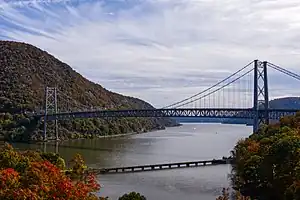 Bear Mountain Bridge in 2022 | |
| Coordinates | 41°19′12″N 73°58′49″W |
| Carries | 2 lanes of |
| Crosses | Hudson River |
| Locale | Cortlandt / Bear Mountain |
| Other name(s) | Purple Heart Veterans Memorial Bridge (ceremonial) |
| Maintained by | New York State Bridge Authority |
| Characteristics | |
| Design | Suspension bridge |
| Total length | 2,255 feet (687 m) |
| Width | 48 feet (15 m) |
| Height | 360 feet (110 m) |
| Longest span | 1,632 feet (497 m)[1] |
| Clearance below | 155 feet (47 m) |
| History | |
| Opened | 1924 |
| Statistics | |
| Daily traffic | 17,695 (2007)[2] |
| Toll | (eastbound only) cars $1.75 cash, $1.45 E-ZPass |
Bear Mountain Bridge | |
  | |
| Location | Cortlandt / Bear Mountain |
| Coordinates | 41°19′12″N 73°58′49″W |
| Built | 1923 |
| Built by | Terry & Tench Construction Co. |
| Engineer | Baird, Howard C. |
| MPS | Hudson Highlands MRA |
| NRHP reference No. | 82001266 |
| Added to NRHP | November 23, 1982[3] |
| Location | |
The span enables connections between the Palisades Interstate Parkway and US 9W on the west bank near Bear Mountain and NY 9D on the east bank as well as US 9 and the Bear Mountain Parkway farther east. It also carries the Appalachian Trail and New York State Bicycle Route 9 across the Hudson.
The bridge has two undivided vehicle lanes flanked by sidewalks. Cyclists may ride with motor vehicle traffic or walk their bikes on the sidewalks.
History
Hudson Highland Suspension Bridge
Plans for a bridge at the site began with the charter of the Hudson Highland Suspension Bridge Company in 1868 after a bill was passed by the legislature and signed by Governor Fenton.[8][9][10] Early investors in the company included Erastus Corning, Isaac Bell, and Addison P. Jones.[10]
The following year, The New York Times reported that a contract had been signed and construction would "speedily commence" on the "Hudson Highland Suspension Bridge" between Fort Clinton and Anthony's Nose. The intent was to carry a railroad toward Derby, Connecticut, to supply coal and iron for industry in the lower Naugatuck Valley. The surface of the bridge was to be 150 feet (46 m) above high tide. In 1871, a board of engineers had been selected to work on the bridge, including Horatio Allen, George B. McClellan, Edward W. Serrell, and Quincy Adams Gillmore. It was reported that capital of $2.5 million was needed and that much of it had been raised from the railroads who would benefit from the bridge. At this time, construction was expected to begin in June 1871 and to be complete by 1875.[11]
In 1887, reports said the bridge would be finished in two years. By 1889, "work on the anchor pits was progressing rapidly."[12] On March 5, 1896, the Hudson Highland Bridge and Railway Company filed for incorporation with capital of $84,900. The company was a reorganization of the former Hudson Suspension Bridge and New England Railway Company.[13]
None of these attempts to build the bridge were successful, with only foundation preparations having progress made.[8] Much of this period coincided with the so-called Long Depression, including stock market crashes called the Panic of 1873 and Panic of 1893. A charter for construction of the bridge expired in 1916.[14]
Bear Mountain Hudson River Bridge Company
In March 1922 through a bill introduced by C. Ernest Smith, the state legislature authorized creation of the private Bear Mountain Hudson River Bridge Company to complete the project. The bridge was now for automobiles instead of rail, and included a 3-mile (4.8 km) approach road from the Albany Post Road north of Peekskill. The 11-member board of directors included financiers E. Roland Harriman and George W. Perkins. Under the 1922 charter, ownership of the bridge was to revert by 1962 to New York State, which also had the right to acquire the bridge at any time.[15] A $4.5 million bond issue was completed in April of that year through the Harriman banking and brokerage firm.
Completion
When the bridge formally opened on November 27, 1924, it was the longest suspension bridge span in the world, and the first of its type to have a concrete deck.[16] It was the first automobile bridge to cross the Hudson south of Albany, and surpassed the 1888 Poughkeepsie Railroad Bridge as the southernmost crossing of the river.[17]
Construction methods pioneered on the Bear Mountain Bridge influenced much larger projects to follow, including the George Washington (1931) and Golden Gate (1937) bridges. Completion also inspired the state to extend the Bronx River Parkway from Kensico Dam northward, work which evolved into the Bear Mountain Parkway and the first phase of the Taconic State Parkway.
New York State Bridge Authority
Ownership was transferred to the New York State Bridge Authority on September 26, 1940, and the toll was reduced to a flat rate of 50 cents per automobile.[18][19] Originally, tolls were collected in both directions. In August 1970, the toll was abolished for westbound drivers, and at the same time, eastbound drivers saw their tolls doubled. The tolls of eleven other New York–New Jersey and Hudson River crossings along a 130-mile (210 km) stretch, from the Outerbridge Crossing in the south to the Rip Van Winkle Bridge in the north, were also changed to eastbound-only at that time.[20]
In 1982 the bridge and its then-abandoned original toll house several miles away on the Peekskill approach road, Routes 6 and 202, were added to the National Register of Historic Places.[3] The bridge was also designated as a local historic civil engineering landmark by the American Society of Civil Engineers in 1986.[8]
In 2019, the bridge authority announced that tolls on its five Hudson River crossings would increase each year beginning in 2020 and ending in 2023. On May 1, 2021, the toll for passenger cars traveling eastbound on the Mid-Hudson Bridge was $1.75 in cash, $1.45 for E-ZPass users. In May 2022, tolls rose to $1.55 for E-ZPass users and $2 for cash payers. In 2023, the E-ZPass toll was set at $1.65, and the cash toll was set at $2.15.[21] Tolls are collected from eastbound travelers only.
At midnight on October 1, 2021, the bridge was converted to all-electronic tolling and only in the eastbound direction. Motorists can use their E-ZPass to pay the toll. Those without E-ZPass are sent a bill in the mail.
Maintenance innovation
The Bridge was used to test several new materials designed to lower the cost and environmental impact of bridge cable maintenance. One of them proved promising.[22]
During routine inspections, bridge cables are unwrapped and wedges are used to separate the individual strands. Inspectors look for signs of moisture and corrosion throughout the cable. For over 100 years, a red lead paste was used to seal the strands against moisture intrusion. In addition to emerging as an environmental hazard during that span, the paste was also prone to drying out and cracking after a few years, creating an ongoing maintenance task.[22]
In the 1990s engineers experimented with several materials on a small section of the cables of the Bear Mountain Bridge. After a year the test areas were reexamined and one polymer-based, non-toxic paste was found to be superior. The bridge cables were then rewrapped in 2000 using the material. Seven years later the cables were found to be free of additional moisture or corrosion. New York State Bridge Authority chief engineer William Moreau expressed hope that the new material may lengthen the life of the cables, and lower the need for inspection and maintenance.[22]
Gallery
.jpg.webp) Aerial view in 1925
Aerial view in 1925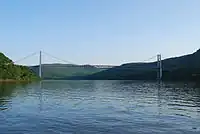 Bear Mountain Bridge in 2009
Bear Mountain Bridge in 2009 Looking east
Looking east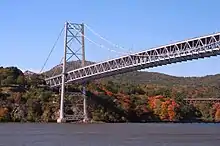 Looking northwest from the east bank
Looking northwest from the east bank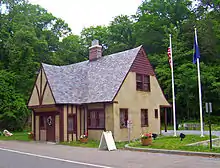 Old Bear Mountain Bridge Toll House along Routes 6 and 202, between the bridge and Peekskill, today used as an information center for surrounding parkland
Old Bear Mountain Bridge Toll House along Routes 6 and 202, between the bridge and Peekskill, today used as an information center for surrounding parkland The Bear Mountain Bridge EZ Pass Toll in August 2011.
The Bear Mountain Bridge EZ Pass Toll in August 2011.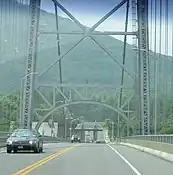 Heading westbound over the bridge
Heading westbound over the bridge
See also
References
- Sources
- Notes
- Guide to Civil Engineering Projects In and Around New York City (2nd ed.). Metropolitan Section, American Society of Civil Engineers. 2009. p. 31.
- "2008 Traffic Data Report for New York State" (PDF). New York State Department of Transportation. Appendix C. Archived from the original (PDF) on September 27, 2012. Retrieved February 27, 2010.
- "National Register Information System". National Register of Historic Places. National Park Service. April 15, 2008.
- Cutler, Nancy (October 4, 2018). "Unlike Tappan Zee, the Bear Mountain Bridge keeps historic name while honoring heroes". lohud.com.
- "Bear Mountain Bridge (US 6 and US 202)". www.nycroads.com. Retrieved October 31, 2020.
- "New York State Bridge Authority Bear Mountain Bridge Page". www.nysba.state.ny.us. Retrieved October 31, 2020.
- "Ben Franklin Bridge". drpa.org. Retrieved October 31, 2020.
- "Bear Mountain Bridge". ASCE Metropolitan Section. Retrieved July 1, 2022.
- "Hudson Highland Bridge and Railway Company Records". Rhode Island Historical Society. Retrieved July 1, 2022.
- "General News". Hartford Courant. Hartford, Connecticut. April 29, 1868. Retrieved July 7, 2022 – via Newspapers.com.
- "The Hudson Bridge: New Railroad Connections-Vast Saving in Time, Trouble and Expense-Coal Direct from the Mines". The New York Times. New York. May 20, 1871. Retrieved August 18, 2022 – via Newspapers.com.
- "The Anthony Nose Bridge.; Work on the Anchor Pits Progressing Rapidly". The New York Times. September 4, 1889. p. 3. Retrieved February 13, 2010.
- "A Suspension Bridge Company". Democrat and Chronicle. Rochester, New York. March 6, 1896. Retrieved July 7, 2022 – via Newspapers.com.
- "New Scenic Motor Highway in Highlands of the Hudson". The New York Times. May 6, 1923. p. XX6. Retrieved February 13, 2010.
- "Would Span Hudson at Bear Mountain". The New York Times. February 9, 1922. p. 27. Retrieved August 23, 2022.
- New York State Bridge Authority. "The Bear Mountain Bridge". Retrieved July 6, 2022.
- "Open New Bridge Over Hudson River". The New York Times. November 27, 1924. p. 21. Retrieved March 27, 2010.
- "State Recaptures Bear Mt Bridge". The New York Times. August 8, 1940. p. 21. Retrieved February 13, 2010.
- "State Will Take Over Bear Mt. Span Today". The New York Times. September 25, 1940. p. 21. Retrieved March 27, 2010.
- Moran, Nancy (August 13, 1970). "One‐Way Tolls Confusing Some Drivers". The New York Times. Retrieved April 9, 2018.
- Doxsey, Patricia (April 12, 2021). "Hudson River bridge tolls for E-ZPass users rise next month". Daily Freeman. Retrieved December 31, 2021.
- "Sticky solution". Bridge Design & Engineering. May 25, 2008. Archived from the original on August 28, 2008. Retrieved August 13, 2008.
External links
- New York State Bridge Authority site
- Bear Mountain Bridge at nycroads.com
- Bear Mountain Bridge at bridgemeister.com
